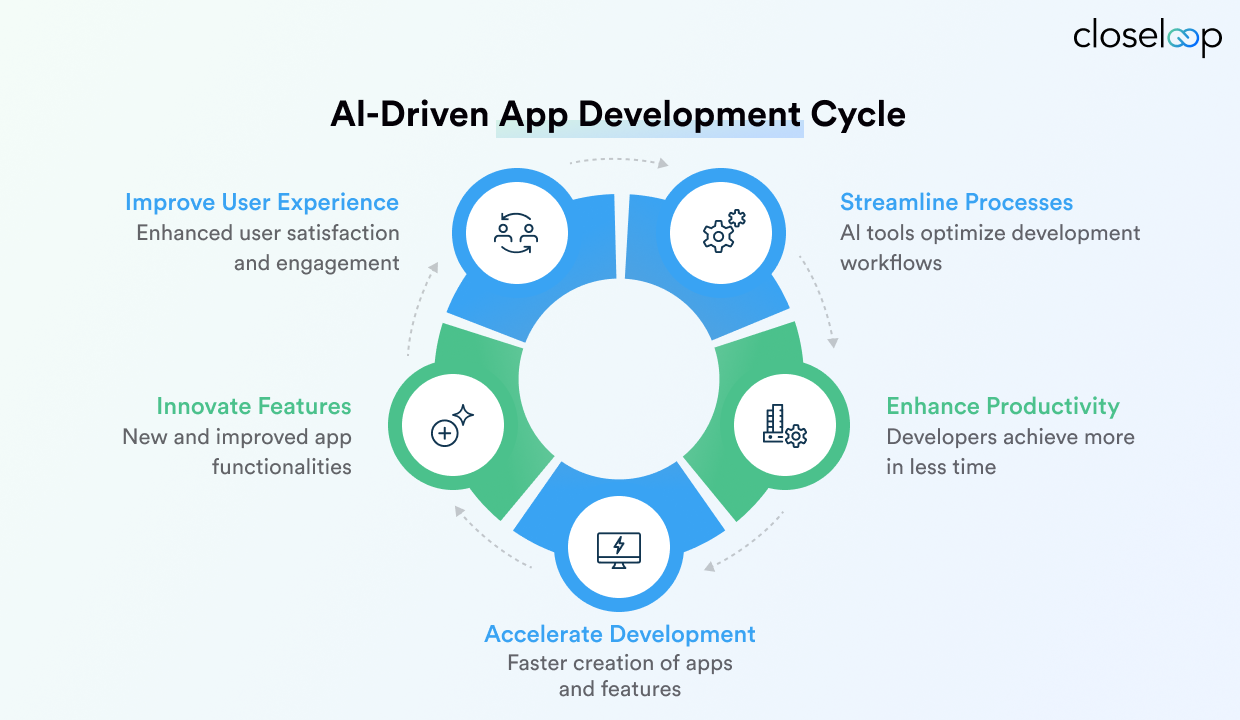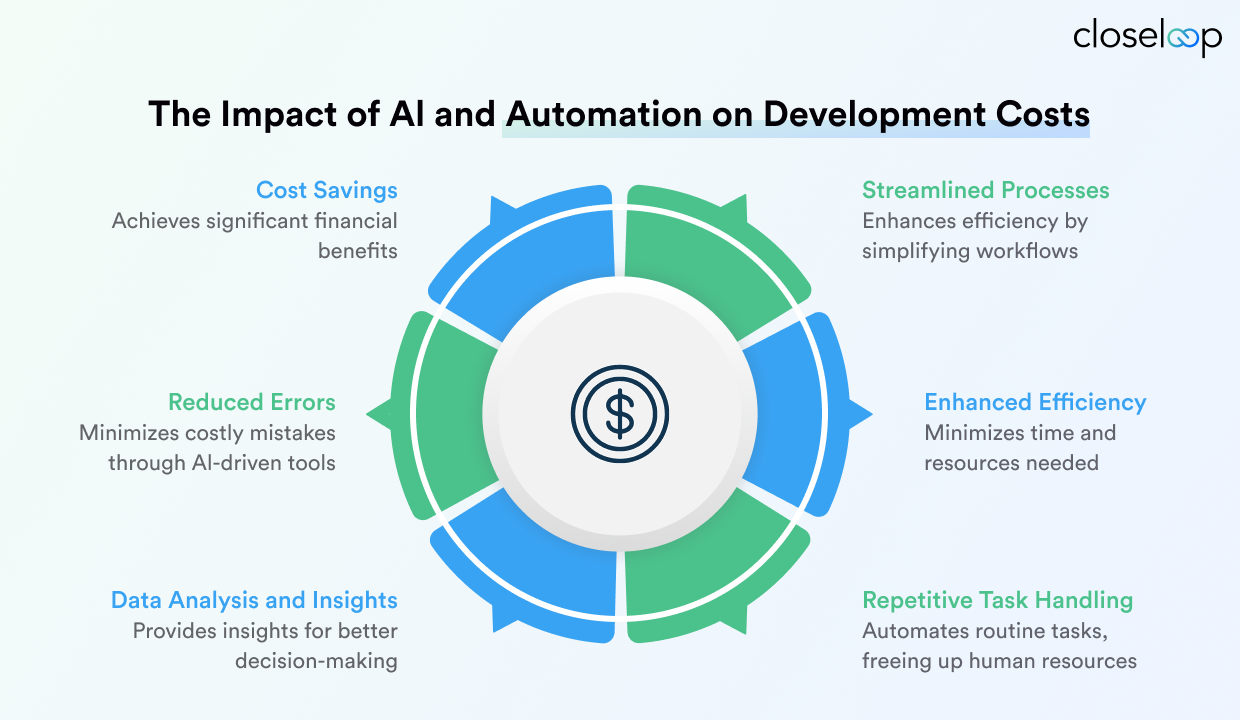Remember when building an app meant assembling 8-12 developers, waiting 12-18 months, and hoping your budget didn't explode by 200%? Those days are rapidly disappearing.
We're witnessing the biggest shift in software development since the internet went mainstream. AI and automation are no longer abstract ideas - they're fundamentally changing how apps get built, tested, and launched. While traditional agencies quote six-figure budgets for basic apps, AI-powered development is delivering similar results in weeks at a fraction of the cost.
A recent client got quoted $150,000 and 8 months for a marketplace app from a traditional agency. Using AI-assisted development and automated testing, we delivered their MVP in 6 weeks for under $40,000. That's becoming the new normal, not an outlier.
The real question isn't whether AI will change development costs - it's whether your business will adapt fast enough to benefit.
This analysis breaks down exactly how AI is reshaping development expenses and which strategies actually work versus the overhyped solutions that underdeliver.
Key Takeaways: What You'll Learn in This Blog
How traditional app development models contribute to high costs and delays
The growing influence of AI and automation across the app development lifecycle
Specific tools and platforms transforming design, coding, testing, and deployment
Real-world examples of companies reducing development costs using AI
Areas where automation offers cost savings and where it may increase expenses
Long-term ROI benefits beyond initial development, including maintenance and personalization
Challenges and limitations of relying on AI in app development
How Closeloop leverages AI-driven workflows to deliver smarter, cost-efficient development solutions
Actionable insights to guide your next AI-powered app development project
Understanding Traditional App Development Costs
Traditional app development has always been expensive, time-consuming, and unpredictable. Before diving into how AI is changing everything, let's look at why conventional development costs so much.
The Manual Reality
Traditional development means writing every line of code by hand, even for common functionality that's been built thousands of times before. Developers spend weeks recreating basic features like user authentication, payment processing, or data validation instead of focusing on unique business logic.
This manual approach follows rigid methodologies - either Waterfall's sequential phases or Agile's iterative sprints. Both require extensive human coordination, documentation, and project management overhead that doesn't directly contribute to your final product but consumes 20-30% of your budget.
Where Your Money Actually Goes
Labor costs dominate everything - skilled developers command $75-150 per hour
Testing phases eat 15-25% of budgets through manual QA processes
Timeline overruns are standard, with 70% of projects exceeding initial estimates
Rework cycles happen when issues surface late in development
Coordination overhead from managing multiple team members and stakeholders
The Hidden Expenses
Quality assurance requires dedicated teams manually executing test cases, documenting bugs, and coordinating fixes. Each round of testing and debugging creates additional cost cycles. Integration challenges between different system components often require expensive specialist consultations.
This traditional model worked when software was simpler, but today's complex applications demand a more efficient approach.
The Rise of AI and Automation in App Development
The integration of AI and automation into software development represents one of the most significant paradigm shifts in the industry's history. This transformation didn't occur overnight but evolved through decades of research, technological advancement, and practical implementation across development workflows.

Brief History of AI Integration
AI's journey into software engineering began in the 1980s with expert systems designed to capture and replicate human expertise in specific domains. Early applications included code generation tools and automated debugging systems, though these were limited by computational constraints and narrow application scopes.
The 2000s marked a significant acceleration with the advent of machine learning algorithms capable of analyzing code patterns and suggesting improvements. Static analysis tools incorporated AI techniques to identify potential bugs, security vulnerabilities, and performance optimization opportunities. However, these tools remained primarily analytical rather than generative.
The breakthrough came in the 2010s with advances in natural language processing and deep learning. Large language models trained on massive code repositories began demonstrating remarkable capabilities in understanding programming languages, generating functional code, and even explaining complex algorithms. The release of tools like GitHub Copilot in 2021 represented a watershed moment, bringing AI-assisted coding to millions of developers worldwide.
ALSO READ: Automating Business Processes with AI
Key Automation Tools and Platforms
Today's development landscape features sophisticated AI-powered tools that address virtually every aspect of the software development lifecycle. GitHub Copilot, powered by OpenAI's Codex model, provides real-time code suggestions and can generate entire functions based on natural language comments. Research indicates that development tasks were completed 55% faster with Copilot, demonstrating significant productivity improvements.
ChatGPT and similar large language models have revolutionized how developers approach problem-solving, code debugging, and learning new technologies. These tools can explain complex concepts, generate boilerplate code, suggest architectural patterns, and even help with code refactoring tasks.
Test automation frameworks have evolved to incorporate AI-driven test generation, where systems can automatically create comprehensive test suites based on code analysis and user behavior patterns. Tools like Testim and Applitools use visual AI to detect UI changes and generate appropriate test cases without manual intervention.
Cloud platforms like AWS CodeWhisperer, Google Cloud's AI Platform, and Microsoft's Azure AI services provide integrated development environments where AI assistance is seamlessly embedded into the coding experience. These platforms combine code generation with automated testing, deployment, and monitoring capabilities.
AI/ML Applications Across Development Phases
Modern AI applications span the entire development lifecycle, from initial concept to post-deployment maintenance. In the planning phase, AI tools analyze market data, user feedback, and competitive landscapes to suggest feature priorities and development approaches. Natural language processing capabilities enable automatic generation of technical specifications from business requirements.
During the design phase, AI-powered tools like Uizard and Adobe's Sensei can generate user interface mockups and wireframes based on textual descriptions or rough sketches. These tools understand design principles, accessibility requirements, and platform-specific conventions, producing professional-quality designs in minutes rather than days.
Code generation has become the most visible application of AI in development. Modern AI assistants can write functional code in multiple programming languages, suggest optimal algorithms for specific problems, and even translate code between different languages and frameworks. The accuracy and sophistication of these tools continue to improve as they're trained on larger, more diverse code repositories.
Testing automation has been revolutionized by AI systems that can generate test cases, predict failure points, and automatically adapt to code changes. Machine learning models analyze application behavior to identify edge cases and potential security vulnerabilities that human testers might overlook.
Deployment and DevOps processes benefit from AI-driven optimization of cloud resources, automatic scaling decisions, and predictive maintenance strategies. AI systems monitor application performance, user behavior, and system metrics to make intelligent decisions about resource allocation and deployment strategies.
Areas Where AI and Automation Reduce Development Costs
AI and automation are rapidly transforming software development, offering powerful avenues to reduce costs. By streamlining repetitive tasks and enhancing efficiency, these technologies enable significant savings across the development lifecycle.

a. Faster Prototyping & Wireframing
AI design tools are revolutionizing how apps move from concept to visual prototype, slashing both time and costs in the process.
Traditional prototyping takes 2-4 weeks of back-and-forth between designers and stakeholders, burning through budget before development even starts. AI-powered platforms like Uizard change this completely - they generate functional prototypes from hand-drawn sketches or simple text descriptions in minutes, not weeks.
The Speed and Savings Are Real
70-80% reduction in initial prototyping costs
Minutes instead of weeks for first-draft prototypes
Multiple design variations generated automatically
Professional standards maintained through AI analysis
Tools like Figma's AI plugins and Adobe Sensei understand design trends, accessibility requirements, and platform conventions. They automatically apply appropriate UI components, suggest layouts, and generate design assets that actually look professional.
The Bigger Picture
This isn't just about speed - it's about democratizing design. Product teams can now explore multiple concepts without hiring expensive UX specialists upfront. You validate ideas earlier, reduce late-stage design changes, and get stakeholder buy-in faster.
The result? You move from concept to development-ready designs in days instead of months, dramatically reducing your project's initial phase costs.
b. Code Generation & Assistance
AI code assistants are game-changers for reducing programming costs. GitHub's research shows developers using Copilot stay focused 73% longer and preserve mental energy during repetitive tasks 87% of the time - that directly translates to faster, cheaper development.
Where AI Coding Shines
Junior developers traditionally need 6-12 months to become productive. With AI assistance suggesting optimal patterns and catching common mistakes, they contribute meaningfully from day one. This slashes training costs and speeds up team scaling.
The biggest impact hits boilerplate code - those repetitive functions developers spend 30-40% of their time writing. Data access layers, API endpoints, and authentication systems generate automatically with high accuracy, freeing developers for actual business logic.
Cost Benefits Beyond Speed
Error prevention catches bugs during coding, not expensive testing phases
Security vulnerability detection happens in real-time
Code reviews get pre-screened by AI, reducing senior developer overhead
Performance issues identified before they reach production
AI assistants essentially give every developer an experienced coding mentor available 24/7. Instead of spending hours debugging or researching solutions, developers get instant suggestions and catch problems immediately. This transforms coding from a trial-and-error process into guided, efficient development.
c. Automated Testing & QA
AI-powered testing has become one of the biggest game-changers in development, transforming QA from a bottleneck into a competitive advantage.
Traditional testing means hiring dedicated QA teams to manually click through your app, execute repetitive test cases, and document every bug they find. It's expensive, slow, and prone to human error.
AI Testing Changes Everything
Modern frameworks like Test.ai and Applitools automatically generate comprehensive test suites by analyzing your code structure and user flows. They catch edge cases that human testers miss and run hundreds of tests in seconds instead of days.
Visual testing detects pixel-level UI changes across devices automatically
Regression testing becomes 80% faster through intelligent test prioritization
Immediate feedback prevents bugs from spreading through your codebase
Cost reduction of 60-80% for UI-heavy applications
The real win? CI servers catch issues the moment developers break something, preventing expensive late-stage bug discoveries. Instead of finding critical issues during final testing (when fixing costs 10x more), problems get flagged immediately.
This immediate feedback loop eliminates the exponential cost increases that happen when bugs hide until deployment. Your developers fix issues while the code is still fresh in their minds.
d. Smart Deployment & CI/CD
Continuous Integration and Continuous Deployment (CI/CD)
AI-enhanced CI/CD pipelines are transforming deployment from a nerve-wracking manual process into a smooth, automated workflow that saves serious money and stress.
Traditional deployments require specialized DevOps teams babysitting every release, manually coordinating updates, and praying nothing breaks in production. AI-powered pipelines analyze code changes, determine optimal testing strategies, and automatically scale infrastructure based on expected load.
The Financial Benefits Are Clear
Deployment speed drops from hours/days to minutes
Infrastructure costs reduce by 30-50% through intelligent scaling
Downtime prevention saves thousands to millions per hour
DevOps staffing needs decrease for routine releases
Smart deployment systems automatically roll back if performance metrics indicate problems, eliminating the panic of broken production releases. They optimize cloud resource usage by predicting load patterns and scaling accordingly, preventing both wasteful over-provisioning and performance-killing under-provisioning.
While you still need DevOps expertise for pipeline setup and maintenance, routine deployments become largely hands-off. This lets organizations optimize staffing models, freeing expensive specialists for strategic work rather than routine release management. The result is faster releases, lower costs, and significantly less deployment anxiety.
e. Predictive Maintenance & Monitoring
AI monitoring systems flip traditional reactive maintenance on its head, shifting to predictive approaches that catch problems before they explode into expensive disasters.
Traditional monitoring waits for things to break, then scrambles to fix them. AI-powered systems learn your app's normal behavior patterns and spot anomalies that signal trouble brewing. This proactive approach prevents 60-80% of potential outages before they impact users.
The Cost Impact is Massive
Downtime prevention saves $5,600-$9,000 per minute for enterprise apps
Performance optimization reduces infrastructure costs by 20-40%
Automated capacity planning eliminates wasteful over-provisioning
Resource utilization improvements through intelligent analysis
Machine learning models continuously analyze user behavior, system metrics, and resource usage to suggest optimizations that boost efficiency while cutting costs. Instead of guessing at server capacity needs, AI predicts usage patterns and scales resources automatically.
The result? Your app runs smoother, costs less to operate, and rarely surprises you with unexpected outages or performance issues. It's like having a crystal ball for your application's health, allowing you to fix problems before users even notice them.
Cost Shifting: Where AI May Increase Expenses
While AI and automation deliver substantial cost reductions in many areas, they also introduce new expense categories that organizations must consider when evaluating the total cost impact of AI-driven development approaches.
Initial Setup and Integration Costs
Implementing AI and automation tools requires significant upfront investment in technology setup, system integration, and workflow modification. Organizations typically need to invest 3-6 months of development time to properly integrate AI tools into existing development workflows, customize configurations for specific project requirements, and establish appropriate governance frameworks.
The integration process often reveals compatibility issues with existing tools and systems, requiring additional development work or third-party integration solutions. Legacy codebases may need refactoring to work effectively with AI-powered tools, adding unexpected costs to the initial implementation phase.
Training and change management represent substantial hidden costs. Development teams need time to learn new AI-powered tools, understand their capabilities and limitations, and adapt existing workflows. This learning curve can temporarily reduce productivity during the transition period, offsetting some of the initial efficiency gains.
Licensing and Subscription Costs
AI tools typically operate on subscription-based pricing models that can add significant ongoing expenses to development budgets. GitHub Copilot, for example, costs $10 per user per month for individual developers or $19 per user per month for business accounts. For large development teams, these costs can quickly accumulate to substantial annual expenses.
Enterprise-grade AI development platforms often require custom pricing negotiations based on usage volumes, team sizes, and specific feature requirements. AI development costs can range from $50,000 to $500,000+, depending on project complexity, with feature-rich AI-based systems typically ranging from $80,000 to $300,000.
Cloud-based AI services introduce variable costs based on usage patterns, API calls, and computational requirements. While these pay-per-use models offer flexibility, they can lead to unexpected expenses if usage patterns exceed initial projections or if AI tools are used inefficiently.
Skilled Staff Requirements
AI-powered development requires specialized expertise that commands premium salaries in the current market. Data scientists, AI engineers, and machine learning specialists typically earn 20-40% more than traditional software developers, reflecting the high demand and limited supply of these skills.
Existing development teams need additional training to effectively utilize AI tools, understand their outputs, and make appropriate decisions about when to accept or modify AI-generated code. This training investment includes both formal education costs and the opportunity cost of reduced productivity during the learning period.
Quality assurance for AI-generated code requires specialized knowledge to identify potential issues, validate AI suggestions, and ensure that automated processes meet quality standards. Organizations often need to invest in additional QA expertise or extensive training for existing QA teams.
Security and Compliance Considerations
AI tools introduce new security considerations that require additional investment in security measures, compliance processes, and risk management frameworks. Code generated by AI systems may inadvertently include security vulnerabilities or fail to comply with industry-specific regulations.
Data privacy concerns arise when AI tools process proprietary code or sensitive business logic. Organizations may need to invest in private AI deployments or enhanced security measures to ensure intellectual property protection.
Compliance with industry regulations becomes more complex when AI systems are involved in code generation or decision-making processes. Industries like healthcare, finance, and aerospace may require additional documentation, audit trails, and validation processes that add to development costs.
Regular security audits of AI-generated code and AI tool configurations add ongoing expenses to the development process. These audits require specialized expertise and tools to identify potential vulnerabilities or compliance issues that might be introduced by automated systems.
Long-Term ROI: Cost Efficiency Beyond Development
The true value proposition of AI and automation in app development extends far beyond initial development cost savings, creating compound benefits that accumulate over the application's entire lifecycle.
Enhanced Scalability and Performance Optimization
AI-powered applications demonstrate superior scalability characteristics compared to traditionally developed applications. Machine learning algorithms continuously analyze usage patterns, system performance, and resource utilization to optimize application behavior automatically. This intelligent optimization reduces the need for manual performance tuning and infrastructure scaling decisions.
The cost implications are substantial for applications that experience variable or growing user bases. Traditional applications often require expensive over-provisioning to handle peak loads, resulting in wasted resources during normal operations. AI-driven scaling can reduce infrastructure costs by 30-50% while maintaining optimal performance levels.
Performance optimization through AI analysis delivers ongoing benefits that compound over time. Machine learning models identify inefficient code patterns, database queries, and API calls that impact application performance. Automated optimization suggestions help development teams continuously improve application efficiency without dedicating substantial resources to performance analysis.
Advanced User Personalization and Engagement
AI-enhanced applications can deliver personalized user experiences that drive higher engagement rates, longer session durations, and improved user retention. These improvements directly translate to better business outcomes and higher return on development investment.
Personalization algorithms analyze user behavior patterns to customize content, features, and user interfaces for individual users. This capability can increase user engagement by 40-60% compared to static applications, resulting in higher conversion rates and customer lifetime value.
The cost benefits of improved user retention are substantial. Acquiring new users typically costs 5-25 times more than retaining existing users. AI-powered personalization features that improve retention rates by even 10-15% can deliver significant ROI over the application's lifetime.
Reduced Post-Launch Support and Maintenance
AI-powered applications require significantly less manual intervention and support compared to traditionally developed applications. Intelligent error handling, automated issue resolution, and proactive maintenance capabilities reduce support ticket volumes and operational overhead.
Predictive maintenance capabilities identify potential issues before they impact users, preventing costly support incidents and emergency fixes. This proactive approach can reduce support costs by 40-60% while improving user satisfaction through better application reliability.
Automated bug detection and resolution capabilities continuously monitor application behavior and automatically fix common issues without human intervention. This capability reduces the ongoing maintenance burden and allows development teams to focus on feature development rather than issue resolution.
Data-Driven Decision Making and Feature Optimization
AI-powered applications generate rich analytics and insights about user behavior, feature usage, and performance characteristics. These insights enable data-driven decision-making about future development priorities and feature investments.
Intelligent A/B testing capabilities automatically test different feature variations and user experience approaches, identifying optimal configurations without manual testing overhead. This automation can improve feature adoption rates by 20-30% while reducing the time and cost associated with traditional user testing approaches.
The compound effect of better decision-making based on AI-generated insights leads to more successful feature development, higher user satisfaction, and improved business outcomes over time.
Challenges and Limitations to Consider
Despite the substantial benefits of AI and automation in app development, organizations must navigate several challenges and limitations that can impact implementation success and cost-effectiveness.
AI's Creative and Contextual Limitations
Complex business logic that requires domain expertise and creative problem-solving remains challenging for current AI systems. Human developers must still handle unique architectural decisions, creative user experience design, and complex integration challenges that require contextual understanding beyond AI capabilities.
AI tools may generate technically correct code that doesn't align with project-specific coding standards, architectural patterns, or business requirements. This misalignment can create additional review and modification work that offsets some of the initial productivity gains.
Over-reliance Risks and Quality Concerns
Organizations risk developing over-dependence on AI tools, potentially leading to skill degradation among development teams. Junior developers who rely heavily on AI assistance may not develop fundamental programming skills and problem-solving capabilities necessary for complex development challenges.
Code quality concerns arise when AI-generated code is accepted without proper review and validation. While AI tools generally produce functional code, they may not always follow best practices for security, performance, or maintainability. Organizations need robust review processes to ensure AI-generated code meets quality standards.
The "black box" nature of some AI systems makes it difficult to understand the reasoning behind generated code or suggestions. This opacity can create challenges in debugging, maintenance, and knowledge transfer within development teams.
Data Security and Privacy Risks
AI development tools often require access to proprietary code repositories and sensitive business logic to provide relevant assistance. This access creates potential security risks if AI providers don't implement appropriate data protection measures or if data is inadvertently shared between organizations.
Intellectual property concerns arise when AI tools trained on public code repositories generate code that may incorporate patterns from other projects. Organizations need to consider potential licensing and intellectual property implications of using AI-generated code in commercial applications.
Compliance challenges emerge in regulated industries where code generation and automated decision-making processes must meet specific audit and documentation requirements. Organizations may need additional processes to validate AI-generated code compliance with industry regulations.
Organizational Change Management
Resistance to AI adoption often comes from experienced developers who may view AI tools as threats to their expertise or job security. Successful implementation requires careful change management to address these concerns and demonstrate how AI tools enhance rather than replace human capabilities.
Integration challenges arise when organizations attempt to incorporate AI tools into existing development workflows without adequate planning or process modification. Successful implementation often requires significant changes to development processes, code review procedures, and quality assurance approaches.
Training requirements for effective AI tool utilization can be substantial, particularly for organizations with large development teams or complex development processes. The learning curve for AI tools varies significantly among team members, potentially creating productivity disparities during transition periods.
Workflow disruption during AI tool implementation can temporarily reduce productivity as teams adapt to new processes and learn to effectively utilize AI capabilities. Organizations need to plan for this transition period and set appropriate expectations for initial implementation phases.
How Closeloop Can Help Reduce App Development Costs with AI & Automation
Closeloop stands at the forefront of AI-driven software development, offering comprehensive solutions that harness the full potential of artificial intelligence and automation to deliver cost-effective, high-quality applications. As a modern development partner, Closeloop combines cutting-edge AI technologies with proven development methodologies to create a unique value proposition for businesses seeking to optimize their development investments.
Closeloop's approach integrates AI tools seamlessly throughout the entire development lifecycle, from initial concept validation to post-deployment optimization. Their methodology leverages advanced AI platforms for requirement analysis, automatically converting business requirements into technical specifications and identifying potential implementation challenges early in the process.
ALSO READ: A comprehensive guide to mobile app development cost
Conclusion
AI and automation are fundamentally reshaping the cost structure of app development—reducing manual effort, accelerating timelines, and improving long-term efficiency. From faster prototyping to intelligent testing and deployment, these technologies help cut development costs while enhancing output quality. However, realizing these benefits requires more than just tools—it demands the right technology partner.
Closeloop brings expertise in integrating AI across the development lifecycle, ensuring strategic and cost-effective implementations. As the digital landscape continues to evolve, forward-thinking adoption of AI-driven workflows is essential for staying competitive. Choosing a partner with the right vision and technical capabilities can unlock substantial value and ensure your development efforts are both future-ready and cost-efficient.
Now is the time to embrace innovation and transform how apps are built. Talk to our consultants.
Start the Conversation
We collaborate with companies worldwide to design custom IT solutions, offer cutting-edge technical consultation, and seamlessly integrate business-changing systems.
Get in TouchUnlock the power of AI and Automation for your business with our no-cost workshop.
Join our team of experts to explore the transformative potential of intelligent automation. From understanding the latest trends to designing tailored solutions, our workshop provides personalized consultations, empowering you to drive growth and efficiency.
Go to Workshop DetailsExplore Our Latest Articles
Stay abreast of what’s trending in the world of technology with our well-researched and curated articles
View More InsightsCost Breakdown to Build a Custom Logistics Software: Complete Guide
Global logistics is transforming faster than ever. Real-time visibility, automation, and AI...
Logistics Software Development Guide: Types, Features, Industry Solutions & Benefits
The logistics and transportation industry is evolving faster than ever. It’s no longer...
From Hurdle to Success: Conquering the Top 5 Cloud Adoption Challenges
Cloud adoption continues to accelerate across enterprises, yet significant barriers persist....
Gen AI for HR: Scaling Impact and Redefining the Workplace
The human resources landscape stands at a critical inflection point. Generative AI in HR has...




